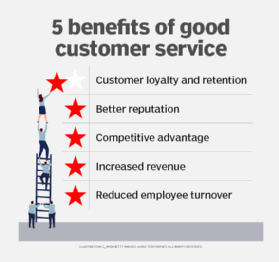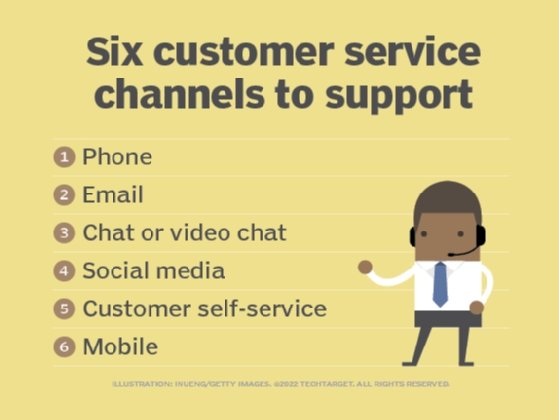Ultimate guide to customer service for businesses
Good customer service can make or break a business -- which is why it's more important than ever to understand customer service and develop a strategy to implement it.
Customer service and support is a crucial department that can determine -- for better or worse -- the success of an organization.
Customer service covers any interaction between an organization and a customer. These interactions include everything from solving problems and answering questions to teaching customers how to use a product or service. Importantly, the interactions can happen across several channels, such as email, phone, social media and automated chatbots. Many of these channels often fall under the scope of a dedicated contact center.
Why is good customer service important?
The customer's experience with a brand or product -- good or bad -- can decide an organization's success and growth opportunity. An outstanding exchange can improve customer retention and create a predictable source of revenue by building customer loyalty. The right interaction can even transform one-time customers into brand ambassadors, each one bringing in more business as the customers spread the word about their experience. On the other hand, bad customer service can have the opposite effect when the customer's story becomes a cautionary tale to others.
To maximize the benefits of good customer service, a customer service manager should start by creating a customer service plan. This plan establishes policies and guidelines for handling customer interactions. It's not possible to account for every conceivable scenario, but a plan provides guidance and a jumping-off point for agents facing a challenge for the first time.
Examples of good vs. bad customer service
Customer service agents need to remember that bad customer service experiences are inevitable. Whether the agent is having an off day or encounters a tense situation with high emotions, an unsatisfied customer is an unfortunate reality for every organization. That doesn't mean a customer service team can't mitigate the likelihood of a bad experience from happening, though. The first step is recognizing the difference between good and bad customer service.
Good customer service
As much as consumers remember bad experiences, moments of good customer service can also stand out. And, because happy customers directly correlate to customer retention and create another avenue for acquiring new customers, going the extra mile can return serious dividends. Here are some common examples of good customer service:
- rapid response time
- knowledgeable agents
- creative problem-solving
- customer self-service options
- loyalty programs
Bad customer service
Everyone will have differing opinions about what constitutes a poor customer experience, but the most common examples of bad customer service include a lack of empathy, slow response time and confusing tools and services. One of the best tools at the disposal of the customer service team is to think about their own experiences with customer service and ask themselves these questions:
- What stood out to me, good or bad, during my last customer service interaction?
- What do I wish organizations did differently when I had a problem or question?
- Are there resources or tools I wish I had, so I didn't have to contact an organization?
- How do I want to be treated when I'm frustrated with a product or service?
Tips and tricks for good customer service
As customer loyalty and retention continues to be a top priority for organizations, it's crucial to invest time and money in the customer experience, particularly for customer service.

Regardless of the industry, there are best practices every organization should follow to deliver excellent customer service. Practices such as implementing a multichannel contact center to talk to customers where they prefer and establishing strong agent onboarding and training practices will go a long way toward making an organization stand out from the competition.
A customer service manager can also look to common customer service challenges and develop a resolution plan for each. The manager can even hold practice interactions to give their agents hands-on experience handling issues such as managing customer expectations, juggling multiple calls at once and not having the answer to a customer's question. This way, when agents encounter a similar experience on the job, they'll have the tools to remain calm and help the customer.
Creating a successful customer service team
A customer service team begins with its leader. A customer service manager guides and oversees the team that responds to customers. As the team lead, the customer service manager must set the tone for handling challenges and toe the line between effective employee management and customer satisfaction.
The customer service team can be thought of as the face of the company because they serve as the mouthpiece for the rest of the organization when questions or problems arise. Therefore, when managers start to recruit their teams, they must find the best possible candidates.
Key skills to look for in a customer service agent
The best customer service agents can combine a positive attitude, empathy, patience and sincerity with problem-solving skills, active listening and clear communication. These skills and personality traits are inherent for some individuals, but others need a little more guidance and training. More specifically, a customer service team should focus on certain customer service skills to see long-term success. Some of the skills to emphasize include active listening, problem-solving, patience, empathy and other similar soft skills.
Types of customer service channels
A customer service channel is any communication method a customer uses to reach an organization. In the past, this was relegated to in-person or phone support only. Now, modern channels such as social media and chatbots have enabled organizations to service customers on their terms.

Phone support
While slowly decreasing in popularity, most organizations still offer a dedicated phone line for customer service. Call management is the process that routes calls to the appropriate call center agent or representative. This can be as straightforward as a singular agent directing each call, or it can involve more advanced systems using technology such as an interactive voice response system to analyze the caller's request and automatically route the caller to the correct agent.
Instead of phone support, an organization might use email to handle customer service. Whether it's integrated into a contact form on the website or an email address is provided, email-based support enables the customer service agent to respond with attachments, valuable links and even step-by-step video guides. The key is choosing the best customer service email template for the scenario.
Social media
Often seen as a way to vent frustration, social media is nevertheless an up-and-coming way customers choose to interact with organizations. Using Twitter, Facebook, Instagram and more, customers can reach out and typically receive a fast response to a question. Brands also use these channels to inject more personality into their interactions, often hoping to create a more personalized and friendly encounter for what could otherwise be a frustrating issue.
Live chat
More organizations have deployed AI-enhanced customer service tools to support CX initiatives. Chatbots, for instance, are software that can understand and simulate human conversation to provide support where and, more critically, when needed.
Self-service
Some modern organizations have begun developing knowledge centers where customers can identify and solve their issues with the help of articles and videos. While every problem can't be solved this way, tech-savvy individuals who enjoy being self-sufficient often prefer to first troubleshoot a question or concern.
Field service management
Customer use field service management (FSM) tools to schedule service calls, track their requests and interact directly with field personnel. The COVID-19 pandemic created new trends in field service management as customer expectations and safety precautions shifted and became even more crucial than before.
While the top FSM vendors have begun integrating new technology into their platforms, they still face the top challenges in field service management, like scheduling, cost, process tracking, time and performance management and customer experience.
The role of the contact center
A contact center serves as a central hub for customer service and is how an individual can interact with an organization across various channels. As the demand for always-on customer service grows, contact centers have become an essential resource for organizations to deploy. This demand has also resulted in the development of contact centers as a service, which adopts a pay-as-you-go model to bring the benefits of a contact center to smaller organizations.
Regardless of an organization's type of contact center, every contact center should consider certain tools and software. CRM software, for example, provides a holistic view of customers and their previous interactions with an organization to ensure customer service agents give the best possible assistance the next time that customer reaches out. AI-enhanced tools are also growing in popularity, as they emphasize efficiency throughout the customer experience.
Types of contact centers
What started as a call center has since evolved into multiple types of contact centers, including the following:
- Inbound contact center. An inbound contact center specializes in handling incoming customer calls and is generally about customer service needs, unlike the calls dealt with at an outbound center.
- Outbound contact center. As the name implies, an outbound center staff reaches out to existing clients or generates new leads. While their popularity is waning, outbound contact centers may handle tasks such as conducting customer surveys, outreach for billing and market research.
- Multichannel contact center. A multichannel contact center is a good example of the evolution of a call center into a contact center. Instead of focusing on a single customer service channel, it manages and processes multiple -- though not all -- means of communication.
- Omnichannel contact center. A multichannel center taken to the next level, an omnichannel contact center affords a single agent access to every interaction with a customer, regardless of the communication channel used.
- Virtual call center. A virtual call center connects agents from anywhere in the world rather than from a single location. This type has risen in popularity due to the boom in remote work that resulted from the COVID-19 pandemic.
Once an organization chooses a contact center type, it must decide how to install it, choosing between an on-premises, cloud or hybrid deployment:
- On-premises contact center. An on-premises contact center is built and managed by an organization and its IT team. While it requires a greater investment of money and dedicated resources, it also puts total control and customization in the organization's hands.
- Cloud contact center. On the other hand, a cloud contact center relies on a public cloud managed by a third-party vendor. The faster implementation and the little to no upgrade or maintenance costs are major selling points.
- Hybrid contact center. As its name implies, a hybrid approach incorporates on-premises and cloud-based contact center technology.
The future of customer service
While the means of interacting with customers will continue to grow and evolve, customer service will always be key to the success of an organization. As more businesses open and industries become saturated with competitors, how an organization treats its customers is one of the top deciding factors for determining where customers spend their money.
As a result, customer service managers and teams should keep an ear to the ground for new and upcoming trends to get an edge over their competition and create a truly unforgettable customer experience.






